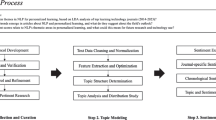Abstract
Many learners have a great interest in technology such as computers and mobile since it is a part of their daily life. The aim of Artificial Intelligence (AI) in education is to develop intelligent tutoring systems (ITS) to support learner learning and reduce student-teacher contact. The most challenging task was to translate the best educational approaches into a Natural Language Processing (NLP) application. Hence, this article explores the relevance and uses of NLP in the context of online language learning, focusing on the use of technology to accelerate the language acquisition. This includes the innovative Artificial Intelligence applications for the analysis of learner emotions by ITS to increase user engagement. The data in this study is analyzed, based on a qualitative approach, and collected from the web and logs of LMS.
Access this chapter
Tax calculation will be finalised at checkout
Purchases are for personal use only
Similar content being viewed by others
Notes
- 1.
This refers to the collection and analysis of learners’ interactions with a computer based tutoring system such as the learner’s engagement with the system, exercises done, time taken to complete, time spent reading and re-reading etc.
References
Siemens, G.: What are learning analytics (2010). http://www.elearnspace.org/blog/2010/08/25/what-are-learning-analytics/
Heemskerk, I., Volman, M., Admiraal, W., ten Dam, G.: Inclusiveness of ICT in secondary education: students’ appreciation of ICT tools. Int. J. Incl. Educ. 16(2), 155–170 (2012)
Kreutz, J., Rhodin, N.: The influence of ICT on learners’ motivation towards learning English. Degree Project in English and Learning (Malmö Högskola Fakulteten för Lärande och Samhälle) (2016). https://muep.mau.se/bitstream/handle/2043/20747/Degree%20Project%20Josefin%20&%20Natalie.pdf?sequence=2. Accessed 05 Oct 2018
Hartnett, M.: The importance of motivation in online learning. In: Hartnett, M. (ed.) Motivation in Online Education, pp. 5–32. Springer, Singapore (2016).https://doi.org/10.1007/978-981-10-0700-2_2
Lepper, M.R., Malone, T.W.: Intrinsic motivation and instructional effectiveness in computer-based education. In: Snow, R.E., Farr, M.J. (eds.) Aptitude, Learning and Instruction. Conative and Affective Process Analyses, vol. 3, pp. 255–286. Lawrence Erlbaum Associates, Hillsdale (1987)
Azmi, N.: The benefits of using ICT in the EFL classroom: from perceived utility to potential challenges. J. Educ. Soc. Res. 7(1), 111–118 (2017)
Jordan, K.: Massive open online course completion rates revisited: assessment, length and attrition. Int. Rev. Res. Open Distrib. Learn. 16(3), 341–358 (2015)
Danka, I.: Motivation by gamification: adapting motivational tools of Massively Multiplayer Online Role-Playing Games (MMORPGs) for peer-to-peer assessment in connectivist Massive Open Online Courses (cMOOCs). Int. Rev. Educ. 66, 75–92 (2020)
Votch, V., Linden, A.: Do You Know What Personalization’ Means? Gartner Group Research Note (2000)
Smith, D.: There are myriad ways to get personal. Internet Week Online (2000)
Dörnyei, Z.: Motivational Strategies in the Language Classroom. Cambridge University Press, Cambridge (2006)
Siemens, G.: Connectivism: a learning theory for the digital age. Int. J. Instr. Technol. Distance Learn. 2(1), 3–10 (2005)
Vygotsky, L.: Thought and Language. MIT Press, Cambridge (1986)
Kukulska-Hulme, A., et al.: Innovating pedagogy 2020: Open University Innovation Report 8 (2020)
Vajjala, S.: Machine Learning in Applied Linguistics. The Encyclopedia of Applied Linguistics, pp. 1–8 (2012)
Fukushima, K., Miyake, S.: Neocognitron: a new algorithm for pattern recognition tolerant of deformations and shifts in position. Pattern Recogn. 15(6), 455–469 (1982)
Keezhatta, M.S.: Understanding EFL linguistic models through relationship between natural language processing and artificial intelligence applications. Arab World Engl. J. 10(4), 251–262 (2019)
Khan, I.A.: Role of applied linguistics in the teaching of English in Saudi Arabia. Int. J. Engl. Linguist. 1(1), 105 (2011)
Richards, J.C.: A non-contrastive approach to error analysis. In: Richards, J.C. (ed.) Error Analysis: Perspectives on Second Language Acquisition, pp. 172–188. Longman, London (1974)
Oliveira Neto, J.D., Cornachione Jr., E., Nascimento, E.: Paving the path for those who come after: designing online instruction to make the best use of previous student’s experiences in light of communal knowledge. In: Proceedings of the Anais 2009, Washington D. C. Academy of Human Resource Development (2009)
Luo, F., Li, C., Cao, Z.: Affective-feature-based sentiment analysis using SVM classifier. In 2016 IEEE 20th International Conference on Computer Supported Cooperative Work in Design (CSCWD), pp. 276–281. IEEE (2016)
Arambepola, N.: Analysing the tweets about distance learning during COVID-19 pandemic using sentiment analysis. In: International Conference on Advances in Computing and Technology (ICACT–2020) Proceedings (2020)
Dichiu, D., Rancea, I.: Using machine learning algorithms for author profiling in social media. In: CLEF (Working Notes), pp. 858–863 (2016)
Devlin, J., et al.: Bert: Pre-training of Deep bidirectional transformers for language understanding. arXiv preprint arXiv:1810.04805 (2018)
Chris, M., Nick, R.: BERT Word Embeddings Tutorial (2019). http://www.mccormickml.com
Author information
Authors and Affiliations
Corresponding author
Editor information
Editors and Affiliations
Rights and permissions
Copyright information
© 2023 The Author(s), under exclusive license to Springer Nature Switzerland AG
About this paper
Cite this paper
Kassimi, M.A., Essayad, A. (2023). Natural Language Processing and Motivation for Language Learning. In: Kacprzyk, J., Ezziyyani, M., Balas, V.E. (eds) International Conference on Advanced Intelligent Systems for Sustainable Development. AI2SD 2022. Lecture Notes in Networks and Systems, vol 637. Springer, Cham. https://doi.org/10.1007/978-3-031-26384-2_26
Download citation
DOI: https://doi.org/10.1007/978-3-031-26384-2_26
Published:
Publisher Name: Springer, Cham
Print ISBN: 978-3-031-26383-5
Online ISBN: 978-3-031-26384-2
eBook Packages: Intelligent Technologies and RoboticsIntelligent Technologies and Robotics (R0)




